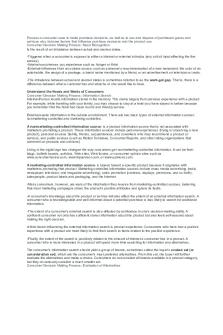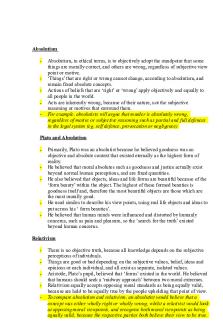1. HW Compare Absolutism and Parliamentariarism PDF

| Title | 1. HW Compare Absolutism and Parliamentariarism |
|---|---|
| Course | Historia Moderna |
| Institution | Universidad Carlos III de Madrid |
| Pages | 2 |
| File Size | 175.4 KB |
| File Type | |
| Total Downloads | 36 |
| Total Views | 148 |
Summary
Download 1. HW Compare Absolutism and Parliamentariarism PDF
Description
ABSOLUTISM: POLITICAL DOCTRINE From the 17th century onwards, most of Europe had an Absolutist political system. Under Absolutism, all the power (political, economical, military, etc). was concentrated in the king. The king took all decisions, created laws, named judges and was head of the Army. Under Absolutism, Monarchy and State can not be divided. The three branches of the state (legislative, executive and judicial) were controlled by the monarch. Absolutism appeared in France during the 17th century, under the reign of Louis XIV. Absolutism was supported by different theories and authors, such as Jacques Bossuet (France, 1627-1704). This French bishop created a theory known as The Divine Right of Kings. The king’s power was provided by God and kings were only responsible in the eyes of God. Absolutism allowed kings not to depend politically on the nobility. The nobility accepted this new situation as their social and economic influence was not only maintained but also expanded. To control their countries and colonies, absolute monarchies also created a strong body of civil servants, permanent diplomats and a powerful army. To pay for all these expenses, taxes were increased on the non privileged groups.
A NEW POLITICAL MODEL: PARLIAMENTARIANISM Absolutism wasn’t successful in all of Europe and a new political model (Parliamentarianism) started to develop in England and the United Provinces during the 17th century. In both cases economic prosperity allowed an important middle class (bourgeoisie) to grow. This new group wanted political representation in accordance with their economic position. They managed to stop the growing power of the king and controlled their parliament. During the 17th century, some English kings tried to impose absolutism and there were severe conflicts between the king and the bourgeoisie, which led to several revolutions. The Glorious Revolution (1688) forced the Stuarts to abdicate and William II of Orange was named the new English king. He had to accept a limitation on his powers and he had to sign a Bill of Rights to acknowledge Parliamentary power. Like Absolutism, Parliamentarianism also had theoretical support. The most important author was John Locke (1632-1704). He developed the Social Contract theory. Locke believed in the state of nature and he thought the government had to ensure and protect the natural rights (for example law and liberty). If the government didn’t respect or ensure these rights the governed would have the right of rebellion.
http://www.tumblr.com/tagged/classical-liberal
Three main ideas were expounded by Locke: liberty (ensured by some basic rights), equality before the law (against the privileges of feudal society) and property as a way of social differentiation. Locke believed that only the owners contribute to the State and only they should have the right to take decisions ( limited suffrage). This theory would be essential in the following centuries and it would be used to justify many liberal revolutions during the 18th and 19th century.
HOMEWORK: Make a table in your notebook to compare absolutism and parlIamentarianism. Include as many items as you can think of....
Similar Free PDFs

Compare AND Contrast Strategy
- 2 Pages

Compare and Contrast SD
- 4 Pages

Hw 1 - quest hw
- 9 Pages

Compare and Contrast
- 2 Pages

Compare
- 5 Pages

Compare and Contrast Essay
- 4 Pages

Compare and Contrast Essay
- 6 Pages

Compare and Contrast Draft 2
- 4 Pages

Jons Compare and Contrast Essay
- 3 Pages

To P Compare and Contrast
- 15 Pages

Compare and Contrast - Grade: A
- 4 Pages
Popular Institutions
- Tinajero National High School - Annex
- Politeknik Caltex Riau
- Yokohama City University
- SGT University
- University of Al-Qadisiyah
- Divine Word College of Vigan
- Techniek College Rotterdam
- Universidade de Santiago
- Universiti Teknologi MARA Cawangan Johor Kampus Pasir Gudang
- Poltekkes Kemenkes Yogyakarta
- Baguio City National High School
- Colegio san marcos
- preparatoria uno
- Centro de Bachillerato Tecnológico Industrial y de Servicios No. 107
- Dalian Maritime University
- Quang Trung Secondary School
- Colegio Tecnológico en Informática
- Corporación Regional de Educación Superior
- Grupo CEDVA
- Dar Al Uloom University
- Centro de Estudios Preuniversitarios de la Universidad Nacional de Ingeniería
- 上智大学
- Aakash International School, Nuna Majara
- San Felipe Neri Catholic School
- Kang Chiao International School - New Taipei City
- Misamis Occidental National High School
- Institución Educativa Escuela Normal Juan Ladrilleros
- Kolehiyo ng Pantukan
- Batanes State College
- Instituto Continental
- Sekolah Menengah Kejuruan Kesehatan Kaltara (Tarakan)
- Colegio de La Inmaculada Concepcion - Cebu




